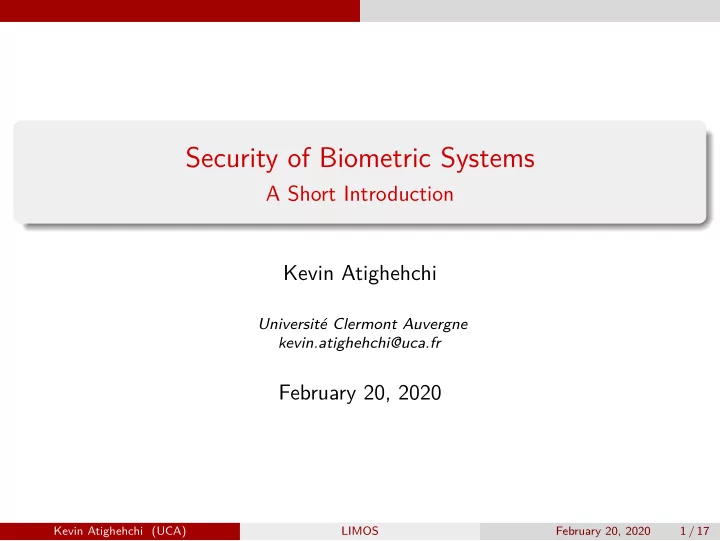

Security of Biometric Systems A Short Introduction Kevin Atighehchi Université Clermont Auvergne kevin.atighehchi@uca.fr February 20, 2020 Kevin Atighehchi (UCA) LIMOS February 20, 2020 1 / 17
Introduction Automated Border Control 2 / 17
Introduction Authentication Factors Authentication Factors • Something I know (password, PIN code, ...) • Something I possess (USB key, smart card, smartphone, ...) • Something I am (morphological, behavioural, biological data) 3 / 17
Introduction Authentication Factors Biometric Modalities 4 / 17
Introduction Principle of a Biometric System Principle of a Biometric System Two steps: • Enrollment (sensing, processing, storage, at earlier time) • Verification or identification (at later time) 5 / 17
Introduction Principle of a Biometric System Decision How to decide if the claimed identity is correct? Suppose SCORE is a similarity matcher of biometric templates. IF SCORE(REFERENCE TEMPLATE, CAPTURED TEMPLATE) > THRESHOLD ACCEPT ELSE REJECT THRESHOLD value is set according to the application 6 / 17
Introduction Privacy Issues Protection des données biométriques Motivation Legislative and regulatory context: • GDPR • Loi Informatique et Libertés (update for compliance with GDPR) • Privacy-by-design , privacy-by-default Biometric data: • A long-term and unique personal identifier • A non-revocable data • Whence categorized as a highly sensitive and private data 7 / 17
Introduction Vulnerabilities Vulnerabilities of a Biometric System Attack points (Model of Ratha et al. , 2001) 1: Sensor attacks 2, 4, 6: Communication channel attacks (eavesdropping, interruption, modification, replay) 3, 5, 8: Attacks on the processing modules (malware injection to control the initial module) 7: Attacks on the templates (compromise of the database) 8 / 17
Introduction Attack Examples Sensor Attack: Make-up 9 / 17
Introduction Attack Examples Sensor Attack: FaceID Spoofing 10 / 17
Introduction Attack Examples Attack on the Decision Module The matcher result (accept or reject) can be overridden by the attacker. 11 / 17
Introduction Attack Examples Attacks on the Matcher: Hill-Climbing The reference template T is compared with the fresh template T ′ , using a metric distance d and a threshold τ . If d ( T, T ′ ) ≤ τ , access to the system is granted. Assumption: The distance is leaked. Let T , T ′ ∈ F n 2 and d the Hamming distance. If each time an authentication attempt the adversary makes he learns the resulting score, then he can recover the template T with only n + 1 attempts . To compare with the ∼ 2 n − t attempts that require a brute-force attack when the distance is not leaked. 12 / 17
Introduction Attack Examples Biometrics with standard cryptography Assumption: the reference biometric template is encrypted with a standard algorithm (AES), by the user (or by the server after a secure transmission), prior its storage on the server. 1 Enrolment phase: The server encrypts the biometric reference template T , sent by the user (variant: the user encrypts his template T and sends it to the server). 2 Verification phase: The user sends a fresh template T ′ to the server. The server decrypts the reference template T and compares it with T ′ . Insights: • Biometric templates are not protected during the verification. If the server is compromised, the biometric template is compromised. • Standard cryptography does not preserve distances. 13 / 17
Introduction Attack Examples Template Database Integrity Assumptions: • The templates of the database are separately protected in integrity, i.e. a MAC or a digital signature is computed on each template (along with the user ID). • The adversary is a user of the system. Insights: • The adversary could swap its own pair of template/MAC with the pair of another user. • The data structure should be authenticated as well. 14 / 17
Introduction Security PET and Security Criteria Crypto-biometric schemes are used to protect biometric templates and are included in the Privacy Enhancing Techonologies, standardized in ISO 24745 (2011). Required criteria in ISO 24745: • Performances • Irreversibility • Unlinkability/diversity (Indistinguishability) • Revocability/renewability 15 / 17
Examples of mechanisms Protection of biometric data Motivation and examples of primitives Biometric data require special treatments adapted to their level of sensitivity: • Protection against a passive attacker • Protection against an active attacker • With a variety of assumptions regarding the communicating systems: - Honest-but-curious server - Server compromise - Authentication device stolen ( e.g. smartphone) Some mechanisms: • Fuzzy {Commitment, Vault, Extractor} • Computations in the encrypted domain • Secure Multi-Party Computation • Cancelable biometric transformations 16 / 17
Questions Thanks for your attention... Questions? 17 / 17
Recommend
More recommend